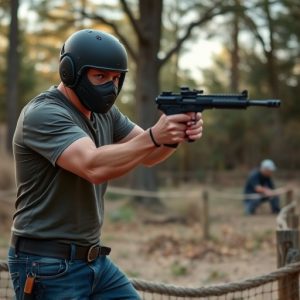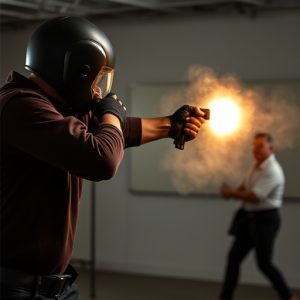Electrical Pulse Frequency: The Science Behind Stun Gun Effectiveness for Seniors
Non-lethal self-defense weapons like stun guns offer senior citizens a powerful and safe option for…….
Non-lethal self-defense weapons like stun guns offer senior citizens a powerful and safe option for personal protection, featuring electrical pulses that temporarily disable aggressors. The key to their effectiveness lies in pulse frequency, with higher settings delivering stronger jolts suitable for robust users while lower settings cater to reduced strength or sensitivity. Adjustable frequency settings, lightweight designs, and ergonomic grips make stun guns an ideal choice for seniors seeking non-lethal force options. Responsible use, including training, proper handling, and awareness of local laws, is crucial to ensure these devices are used effectively and safely.
Stun guns, also known as electronic control devices (ECDs), offer a non-lethal option for personal protection. This article delves into the world of stun guns, focusing on their effectiveness and suitability as self-defense tools for seniors. We explore the crucial role of electrical pulse frequency in stun gun performance, explaining how it disrupts motor functions to immobilize an assailant. Additionally, we provide insights into choosing the right stun gun, safety considerations, and training for responsible use, particularly emphasizing options designed for older adults seeking non-lethal self-defense solutions.
- Understanding Stun Guns: A Non-lethal Option for Self-Defense
- The Role of Electrical Pulse Frequency in Stun Gun Effectiveness
- How Stun Guns Disrupt Motor Functions: A Scientific Perspective
- Choosing the Right Stun Gun: Considerations for Seniors
- Safety and Training: Ensuring Effective and Responsible Use
Understanding Stun Guns: A Non-lethal Option for Self-Defense
Stun guns, also known as electronic control devices (ECDs), are non-lethal self-defense weapons designed to incapacitate an aggressor temporarily. They emit a powerful electrical pulse that disrupts the nerve signals in the body, causing muscular spasms and disorientation. This makes them an attractive option for seniors looking for effective yet safe personal protection. Unlike traditional firearms, stun guns do not use bullets or cause permanent physical harm, making them ideal for those who want to deter potential threats without resorting to lethal force.
For seniors, the appeal of stun guns lies in their ease of use and minimal training requirements. Many models are designed with simple triggers that require minimal effort to activate, ensuring users can defend themselves effectively during an emergency. Moreover, understanding the electrical pulse frequency becomes less critical for seniors compared to law enforcement or military personnel. What matters most is the weapon’s ability to stop an attacker quickly and safely, offering peace of mind and a valuable tool for personal security.
The Role of Electrical Pulse Frequency in Stun Gun Effectiveness
The electrical pulse frequency is a critical factor in determining the effectiveness of stun guns, especially for non-lethal self-defense weapons designed for seniors or individuals seeking less-than-deadly force options. A higher frequency means more rapid and powerful electrical pulses, which can enhance the disruption of muscular control and movement. This results in a more effective stun, allowing users to incapacitate an attacker quickly and safely without causing permanent harm.
For non-lethal self-defense weapons, striking a balance between power and safety is paramount. Stun guns with adjustable frequency settings offer a versatile solution. Seniors or individuals with reduced strength or sensitivity can opt for lower frequencies that still deliver a strong stun but minimize the risk of accidental discharge or excessive force. Higher frequencies are suitable for more robust users who require an extra powerful response, ensuring the weapon remains effective in various self-defense scenarios.
How Stun Guns Disrupt Motor Functions: A Scientific Perspective
Stun guns, or electroshock weapons, work by delivering a powerful electrical pulse to disrupt an individual’s motor functions. From a scientific standpoint, this disruption occurs through the overstimulation of nerve fibers in the body. When activated, the stun gun generates a high-voltage, low-amperage electric current that travels through the target’s skin and into their nervous system. This sudden impulse can cause muscles to contract uncontrollably, leading to temporary paralysis and immobilization.
The effect is particularly effective for non-lethal self-defense weapons designed for seniors or individuals seeking protection without causing permanent harm. The electrical pulse frequency and intensity are precisely calibrated to incapacitate an assailant while minimizing the risk of severe injury. This scientific approach ensures that stun guns provide a safe alternative for personal security, allowing users to defend themselves with confidence in various situations.
Choosing the Right Stun Gun: Considerations for Seniors
When considering non-lethal self-defense weapons, seniors have unique needs and considerations. The primary goal is to find a device that provides effective protection without causing harm or injury, which is where stun guns excel as a safe option. Choosing the right stun gun involves understanding its electrical pulse frequency (EPF). A higher EPF ensures more powerful jolts, making it an ideal choice for individuals seeking robust defense.
However, seniors should opt for models with adjustable settings to tailor the intensity to their comfort level and physical capabilities. This flexibility allows them to use the stun gun confidently while minimizing the risk of accidental shocks or injuries. Additionally, lightweight designs and ergonomic grips are essential features to ensure ease of use, making it a convenient non-lethal self-defense weapon for seniors to carry for their safety.
Safety and Training: Ensuring Effective and Responsible Use
The safe and responsible use of stun guns is paramount, especially for those considering non-lethal self-defense weapons like stun guns as a means of protection, particularly for seniors. Training is crucial to ensure that users understand the device’s functionality, limitations, and potential risks. Many stun gun manufacturers offer safety guidelines and training videos, which can equip individuals with the knowledge to deploy their devices effectively while minimizing harm to themselves and others.
Proper handling and awareness of local laws regarding stun guns are essential components of responsible ownership. Users should be educated on the pulse frequency settings, understanding that higher frequencies may cause more discomfort but could potentially increase the risk of muscle or nerve damage. Training programs often emphasize the importance of de-escalation techniques, ensuring individuals use their stun guns only as a last resort and understand the physical consequences to help them make informed decisions in potentially dangerous situations.
Stun guns, as non-lethal self-defense weapons, offer a crucial option for seniors seeking protection. Understanding the electrical pulse frequency is key to their effectiveness; higher frequencies can disrupt muscle control more efficiently, ensuring a safer and more reliable response in potentially dangerous situations. When choosing a stun gun, consider age-appropriate features and always prioritize safety through proper training. With responsible use, these devices can empower individuals to maintain their independence and security.


